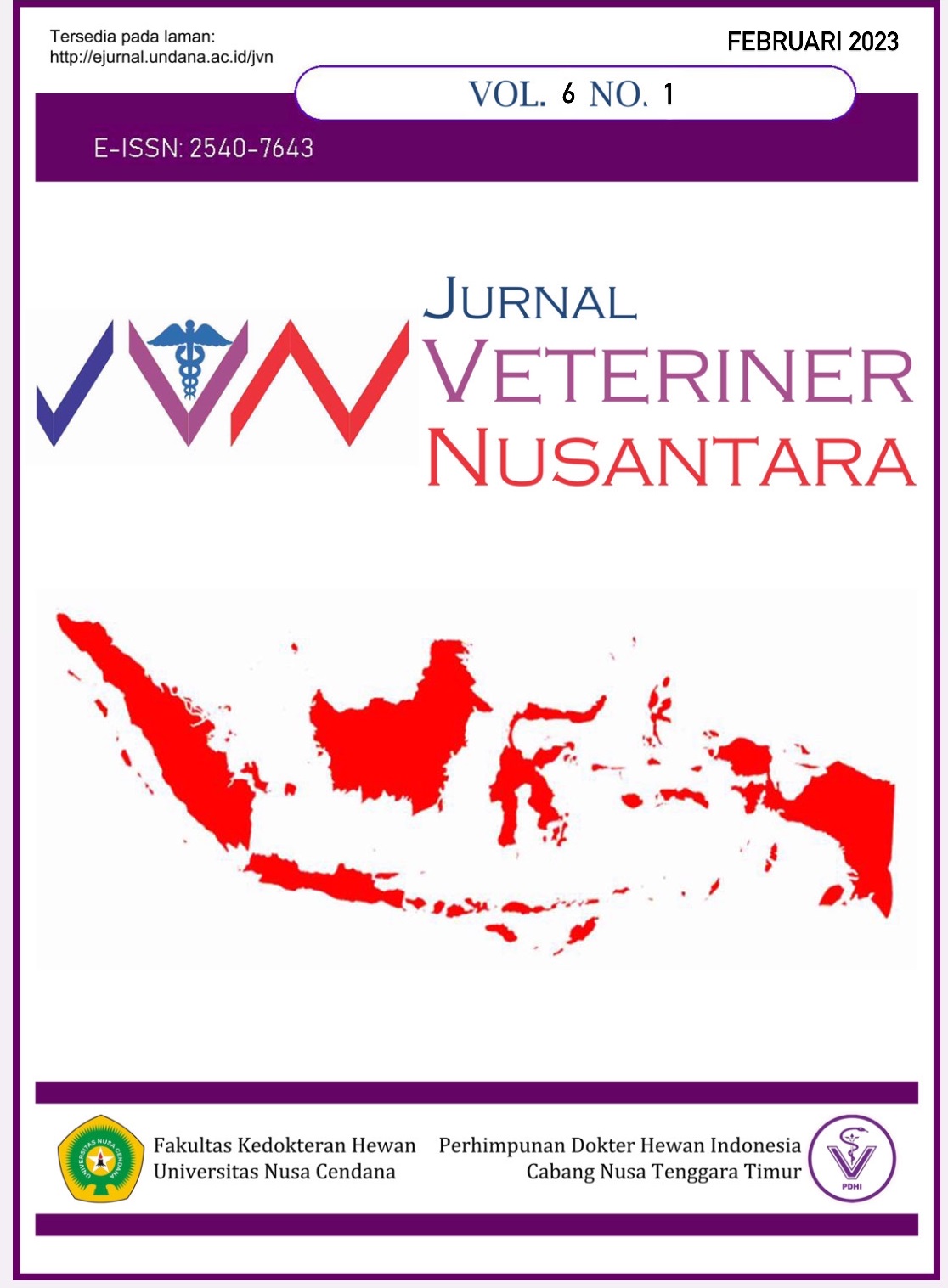Studi Literatur Pengendalian Koksidiosis pada Ternak Ruminansia di Lahan Kering Nusa Tenggara Timur
Abstract
Coccidiosis is a gastrointestinal parasitic disease caused by the protozoan Eimeria spp. The infective form of Eimeria is the oocyst that can be found in almost all tropical environmental conditions and the possibility of disease as an opener to other agents. The percentage of coccidiosis incidence in East Nusa Tenggara (NTT) is increasing from year to year, this is due to many factors that play a role in the spread of coccidiosis in livestock. One of them is the level of resistance of Eimeria oocysts, which can last a long time, so that they remain vigilant and more attention needs to be paid to prevent the spread. The purpose of compiling this literature study is to determine the risk factors associated with the incidence of coccidiosis in ruminants and control of coccidiosis in ruminants in dry land of East Nusa Tenggara. This literature study was obtained from searching and collecting from various reference sources using Google Scholar with the help of the Mendeley application. There are 53 literatures obtained and after being analyzed and known risk factors related to the incidence of coccidiosis are maintenance management, season (temperature and humidity), environmental conditions, age of livestock, and sex. Coccidiosis control in ruminants can be done with coccidiostat therapy and herbal ingredients as well as improving management this case regular sanitation and cleanliness of cages, stables for adults and young livestock, rotation of pastures, containers or feed containers on a regular basis and endeavored to avoid contamination by feces.
Downloads
References
Arsani NM, Saraswati NKH, Sutawijaya IGM, Yunanto. 2016. Surveilans parasit gastrointestinal pada ternak sapi dan kerbau di Provinsi Bali, NTB dan NTT. [Laporan Teknis]. Denpasar: Balai Besar Veteriner Denpasar direktorat Jenderal Peternakan dan Kesehatan Hewan Kementerian Pertanian.
Bangoura B, Mundt HC, Schmäschke R, Westphal B, Daugschies A. 2012. Prevalence of Eimeria bovis and Eimeria zuernii in German cattle herds and factors influencing oocyst excretion. J Parasitol Res, 110: 875-881.
Berek HSD, Matutina V. 2017. Pemeriksaan dan identifikasi parasite gastrointestinal pada sapi bali di Nusa Tenggara Timur Tahun 2017. Prosiding Penyidikan Penyakit Hewan Rapat Teknis dan Pertemuan Ilmiah (RATEKPIL) dan Surveilans Kesehatam.
[BPS]. 2021. Geografi dan Iklim Provinsi Nusa Tenggara Timur. Badan Pusat Statistik Provinsi Nusa Tenggara Timur Dalam Angka 2021.
Daugschies A, Najdrowski M. 2005. Eimeriosis in cattle: current understanding. J Vet Med B Infect Dis Vet Public Health, 52: 417-427.
Davoudi Y, Garedaghi Y, Nourmohammadzadeh F, Eftekhari Z, Safarmashaei S. 2011. Study on prevalence rate of coccidiosis in diarrheic calves in East-Azerbaijan province. Adv. Environ. Biol, 5(7): 1563-1565.
Ekawasti F, Nurcahyo W, Wardhana AH, Shibahara T, Tokoro M, Sasai K, Matsubayashi M. 2019. Molecular characterization of highly pathogenic Eimeria species among beef cattle on Java Island, Indonesia. J Par Inter, 72:101927.
Fitriastuti ER, Atikah N, Ria NM. 2011. Studi Penyakit Koksidiosis pada Sapi Betina di 9 Provinsi di Indonesia Tahun 2011. Bogor: Balai Besar Pengujian Mutu dan Sertifikasi Obar Hewan.
Frimawaty E, Basukriadi A, Syamsu JA, Soesilo TEB. 2011. Eco-farming melalui sistem integrasi tanaman dan ternak untuk keberlanjutan sumberdaya pangan. Penelitian Masalah Lingkungan di Indonesia, 191-198.
Hau DK, Pohan A, Nulik J. 2015. Penyakit-penyakit zoonosis di Nusa Tenggara Timur. Research Gate, 32:330–333.
Heidari H, Gharekhani J. 2014. Detection of Eimeria species in Iranian native cattle. Int J Adv Res, 2: 731-734.
Hess HD, Kreuzer M, Diaz TE, Lascano CE, Carulla JE, Soliva CR. 2003. Saponin rich tropical methanogenesis in faunated and fruits affect fermentation and defaunated fluid. J. Anim Feed Sci Technol, 109:79–94Hidayah N. 2016. Pemanfaatan senyawa metabolit sekunder tanaman (tanin dan saponin) dalam mengurangi emisi metan ternak ruminansia. Jurnal Sain Peternakan Indonesia, 11(2): 89-98.
Himmelstsjerna S, Epe C, Wirtherle N, Heyden VVD, Welz C, Radeloff L, Beening J, Carr D, Hellmann K, Schnieder T, Krieger K. 2005. Clinical and epidemiological characteristic of Eimeria infections in first year grazing cattle. J vet parasitol, 136(2006): 215-221.
Indraswari AAS, Suwiti NK, Apsari IAP. 2017. Protozoa gastrointestinal: Eimeria Auburnensia dan Eimeria Bovis menginfeksi sapi bali di Nusa Penia. Buletin Veteriner Undayana, 9(1): 112-116.
Indrati R. 2021. Efektivitas ekstrak Andrographolide paniculata terhadap profil darah, infeksi ookista, dan produksi Kambing Peranakan Etawah. Prosiding Seminar Teknologi Agribisnis Peternakan Fakultas Peternakan Universitas Jenderal Soedirman, 8: 164-170.
Jittapalapong S, Saengow S, Pinyopanuwat N, Chimnoi W, Khachaeram W, Stich RW. 2012. Gastrointestinal helminthic and protozoal infections of goats in Satun, Thailand. Jurnal of Tropical Medicine and Parasitology, 35: 48-54.
Jonsson NN, Piper EK, Gray CP, Deniz A, Constantinoiu CC. 2011. Efficacy of toltrazuril 5% suspension against Eimeria bovis and Eimeria zuernii in calves and observations on the associated immunopathology. Parasitol Res, 109: S113-S128.
Kertawirawan IPA, Budiari LG, Sutresna IN. 2019. Identifikasi prevalensi Eimeria sp pada sapi bali di lahan marginal dengan pola budidaya semi intensif. Prosiding Seminar Nasional Kesiapan Sumber Daya Pertanian dan Inovasi Spesifik Lokasi Memasuki Era Industri, 281-285.
Keeton ST, Navarre CB. 2018. Coccidiosis in large and small ruminants. Vet Clin North Am Food Anim Pract, 34: 201-208.
Lassen B, Lepik T, Jarvis T. 2014. Seasonal recovery of Eimeria oocysts from soil on naturally contaminated pastures. Parasitol Res, 113:993-999.
Maas J. 2007. Coccidiosis in cattle, UCD Vet Views California Cattlemen’s Magazine. California (USA): School of Veterinary Medicine University of California.
Makau DN. 2014. A Study Of Factors Associated With The Prevalence Of Coccidia Infection In Cattle And Its Spatial Epidemiology in Busia, Bungoma and Siaya Counties, Kenya. [Tesis]. Nairobi (Kenya): University of Nairobi.
Mastra IK, Arsani NM, Nurlatifah I, Sutawijaya IM dan Yunanto., 2015. Surveilan dan Monitoring Parasit Gastro Intestinal di Provinsi Bali, Nusa Tenggara Barat dan Nusa Tenggara Timur [Laporan Teknis]. Denpasar: Balai Besar Veteriner Denpasar Direktorat Jenderal Peternakan dan Kesehatan Hewan Kementerian Pertanian.
Matsubayashi M, Kita T, Narushima T, Kimata I, Tani H, Sasai K, Baba E. (2009). Coprological survey of parasitic infections in pigs and cattle in slaughterhouse in Osaka, Japan. Journal of Veterinary Medical Science, 71(8): 1079-1083.
Muhamad N, Awaludin A, Nugraheni YR. 2021. Koksidiosis pada sapi perah di Kabupaten Jember, jawa timur. Jurnal Ilmu Peternakan Terapan, 4(2): 60-65
Oluwadare AT, Ajayi JA, Ajayi OO, Ogwurike BA, Olaniyan O, Ogon NI. 2010. Studies on Some Aspects of the Bionomics of Bovine Coccidiosis in Plateau State, Nigeria. Niggr Ann Nat Sciens, 10 (1): 9-27.
Patra AK, Saxena J. 2010. A new perspective on the use of plant secondary metabolites to inhibit methanogenesis in the rumen. J. Phytochemistry, 71: 1198– 1222.
Pedersen S. 2013. Coccidiosis in cattle and sheep control nd management methods. Sptlight Pars Diss, 1: 18-19.
Pence M. 2011. Coccidiosis in cattle. University of Georgia, College of Veterinary Medicine, 1-3.
Priyanto D. 2016.Strategi pengembalian wilayah Nusa Tenggara Timur sebagai sumber ternak sapi potong. Jurnal Litbang Pertanian, 35(4): 167-178.
Rahmawati E, Apsari IAP, Dwinata IM. 2018. Prevalensi infeksi protozoa gastrointestinal pada sapi bali di lahan basah dan kering di kabupaten Badung. Indonesia Medicus veterinus, 7(4): 324-334.
Sufi IM, Cahyaningsih U, Sudarnika E. 2016. Prevalensi dan faktor risiko koksidiosis pada sapi perah di Kabupaten Bandung, Jurnal kedokteran Hewan, 10(2): 195-199.
Suratma NA, Oka IBM, Dwinata IM. 2014. Studi Epidemologi Koksidiosis Pada Sapi Di Bali. Prosiding Seminar Nasional Biosains I 2014 “Biodiversitas sebagai Penunjang ketahanan Pangan”. Denpasar.
Taryu. 2015. Koksidiosis pada sapi potong di Sekolah Peternakan Rakyat (SPR) Kecamatan Kasiman kabupaten Bojonegoro. [Tesis]. Bogor: Institut Pertanian Bogor.
Winarso A. 2018. Infeksi parasit gastrointestinal pada kambing di Kupang. ARSHI Veterinary Letters, 2(2): 25-26.
Zahid M. 2015. Kajian Pustaka analisis residu koksidiostat di dalam produk makanan. Buletin pengujian mutu dan sertifikasi obat Hewan, Bogor, 24: 14-51
Copyright (c) 2022 Anjelika Masneno

This work is licensed under a Creative Commons Attribution-ShareAlike 4.0 International License.

 Anjelika Masneno(1*)
Anjelika Masneno(1*)



 Visit Our G Scholar Profile
Visit Our G Scholar Profile




